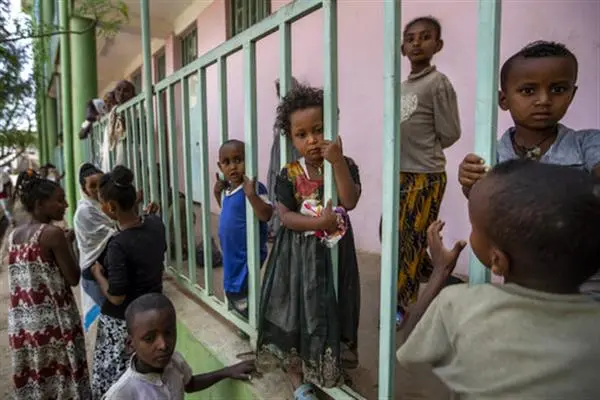
Tigray War: More Than 88 % Classrooms and 95% Instruments Vandalized, Destroyed in a Systematic Attack on Tigray’s Education, Study Showed
– The study showed classroom to students ratio in elementary schools has risen to 434 from just 39 before the war, and small kids have now to walk 7.3 kilometers on average to get to school.
– Education has been one of the areas in the region that has been under intense and systematic attack by the Ethiopian and Eritrean troops, reports show.
Source: Globe News Net
A study on the damage to the education sector in Tigray showed that years of progress on the sector have been reversed with more that 88 % classrooms severely damaged and more than 95 % of their instruments vandalized and destroyed.
A preliminary assessment conducted by the Tigray education bureau involved 2,054 primary, elementary and secondary public schools and two teachers’ training college. The study didn’t include schools that are found in the Western and parts of Northern Tigray which are under Eritrea’s and Amhara’s occupation. The study also didn’t cover universities, private colleges , and vocational training colleges.
Head of Tigray Education Bureau, Dr. Shishay Amare said that his bureau has been able to compile identity of 1,911 students and 235 elementary and high-school teachers who have been killed during the war.

The study by the regional education bureau has found that 88.3 % classrooms have been severely damaged. The study also found out that 96.5 of student desks, 95.9 % blackboards, 63.5 % students textbooks have been stolen, torn, and burnt down.
The study by the regional Education bureau also found that 85.1 % computers, 79.9 % plasma screens, 84.5 % science laboratory equipment, and 92.5 % various educational models have been vandalized and destroyed. The study also found that more than 48 % of toilets have been destroyed.
The study said that Abi-Adi teachers college has been completely (irreparably) destroyed.
According to the study, primary school students now will have to walk 7.3 kilometers to get to school; it was only 2.5 kilometers 16 moths ago. Similarly, high schools will have to walk 17 kilometers to get to their schools from just 7 kilometers before November 2020.
Education has been one of the areas in the region that has been under intense and systematic attack by the Ethiopian and Eritrean troops.
The study also showed that the class to students ratio has skyrocketed to 434 a class from just 39 in Primary schools before the war. In high-schools, the ration has gone up to 365 from just 43 before the war.
Dr. Shishay Amare, the bureau head, said that the education sector has been deliberately targeted by Ethiopian and Eritrean governments to leave Tigrayans in the ‘darkness of ignorance’.
Many believe, Ethiopia, Eritrea, and regional allies have deliberately destroyed everything that is potentially usable by the civilian population in Tigray, during the war.
Human Rights Watch in May 2021 said that schools in Tigray were being targeted, occupied, attacked, and pillaged.
MSF in March 2021said that Ethiopian and Eritrean forces were deliberately targeting health facilities, rendering them non-functional for the public.
The war began in November 2020 when Ethiopia’s army, backed by Eritrean and Somalia national armies and troops from Ethiopian regional states, moved to oust a TPLF-led regional government in Tigray after a long-standing political hostilities between Abiy’s ruling party and the TPLF. The other dimension of the war was a genocidal campaign that has been brewing by elites from Amhara and Eritrean government. The trio combined their forces to unleash the November 2020 ‘war-of-annihilation’ on Tigrayans.
The more than 16-month-old war was marked by extreme brutality, including the use of rape and hunger as weapons of war, massacres and ethnic cleansing against Tigrayans. As a result, the conflict has left thousands dead and forced many others to flee their homes with hundreds of thousands driven to the brink of starvation, according to the United Nations.
Since June, Tigray has been put under a total humanitarian blockade by the Ethiopian government, with only less than 10 %of the needed essential aid allowed to enter the region and no aid reached the region since December 15, 2021. This has resulted in man-made famine to more than 900,000 people in the region and more than 5400 deaths as a result.
The World Health Organization last month called for “unfettered access” into war-wracked Tigray, saying its first delivery of life-saving medical supplies since July last year had stalled due to lack of fuel.
Nearly 40 percent of people in Tigray, a region of six million people, face “an extreme lack of food”, the UN said last month. The dire assessment published by the World Food Programme (WFP) came as humanitarian groups increasingly curtail activities because of fuel and supply shortages.
The UN rights office last week reported that at least 304 civilians had been killed in air strikes in the north, particularly Tigray, since November. The UH Rights office also said that it has received reports of “306 rape incidents by Tigrayan forces in the Amhara region” between November 1 and Dec. 5, 2021.
A recent study by Mekelle University and the Regional Health Bureau showed that 120,000 women in a conservative Tigray came forward to report rape by either Ethiopian, Eritrean, or Amhara. Researchers say that the figure was only a tip of the iceberg, considering the sexual conservativism in Tigray into account. Tigray regional health bureau announced today that 7.3 % of the women who have been raped have been contracted with various sexually transmitted diseases (STDs) and 5 % have been infected with HIV.
An estimated 9.4 million people in northern Ethiopia’s Tigray, Amhara, and Afar regions are in desperate need of humanitarian assistance. Millions more are also suffering from severe food shortages, acute malnutrition is rising, disease and chronic illnesses are going untreated.
